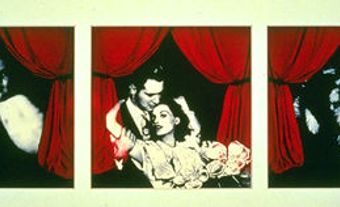Evergon
Evergon, photographer (b at Niagara Falls, Ont 1946). The artist abandoned his birth name at the beginning of his professional career. He received a Bachelor of Fine Arts from MOUNT ALLISON UNIVERSITY in Sackville, NB, in 1970, and an MFA from the Rochester Institute of Technology in 1974. Since that time Evergon has achieved an international reputation as an artist and teacher, especially for his use of an extensive range of traditional and innovative photographic techniques. These range from exploration of long-neglected historical printing techniques through his pioneering use of colour photocopying, Polaroid photography and holography. His works are in the collections of major museums in Canada and abroad.
Exotic Props
A constant through all of Evergon's various explorations of photographic media has been a preoccupation with their imaginary rather than documentary possibilities. Through his staging of models and exotic props or by means of collaged images, Evergon has created tableaux resembling more the traditions of European painting than the conventions of photography. Another distinguishing factor has been his equally painterly interest in colour throughout much of his career. Like many artists, Evergon works through successive motifs expressed in specific techniques or formats in bodies of related works that often occupy several years' duration.
The artist's early work with nonsilver photographic printing techniques, such as the cyanotype, was followed by his collage work with colour photocopying. His work with composite Polaroid images of the early 1980s was superseded by his pioneering use of a unique large-format Polaroid camera at the Boston Museum of Fine Arts producing 1 x 2 m prints. This format led to increasingly theatrical arrangements of lighting, costume, models and props in reworkings of Renaissance and Baroque paintings, subsequently an exploration of circus motifs. Other themes have included tableaux documenting an imaginary race of "Ramboys," half satyr and half urban hustler, and an exploration of gay cruising grounds called "Manscapes." Recently, the artist has created a series of over life-size nudes images of his mother titled "Margaret & I" and another series, called "Chez Moi: Domestic Content," incorporates self-portraits combined with personal memorabilia.
Diverse Sexualities
A consistent preoccupation of the artist has been a candid and, at its origin, audacious exploration of his homosexuality. An early participant in the Canadian gay rights movement, Evergon played a major role in initiating a positive and open climate within Canadian cultural institutions towards presentations of diverse sexualities. Although much of his work is characterized as homoeroticism, his exploration of his own sexuality has led to an ongoing exploration of the social construction of gender, particularly of masculinity, although he has also consistently worked with women models. His forthright representation of sexual subjects has won an enthusiastic audience within and beyond the gay community, as well as detractors who see his work quite correctly as an attack on the conservative values which they cherish.
During the Saskatoon exhibition of an itinerant retrospective of his work from 1971 to 1987, organized by the Canadian Museum of Contemporary Photography in 1989, Evergon and his images became the focus of impassioned debate on artistic freedom of expression, community standards and the autonomy of publicly funded cultural institutions. Highly idiosyncratic, Evergon's work is nonetheless very accessible. Popular without being populist, his work continually explores contemporary social issues within the discourse of a profoundly subjective imagination.

 Share on Facebook
Share on Facebook Share on X
Share on X Share by Email
Share by Email Share on Google Classroom
Share on Google Classroom




